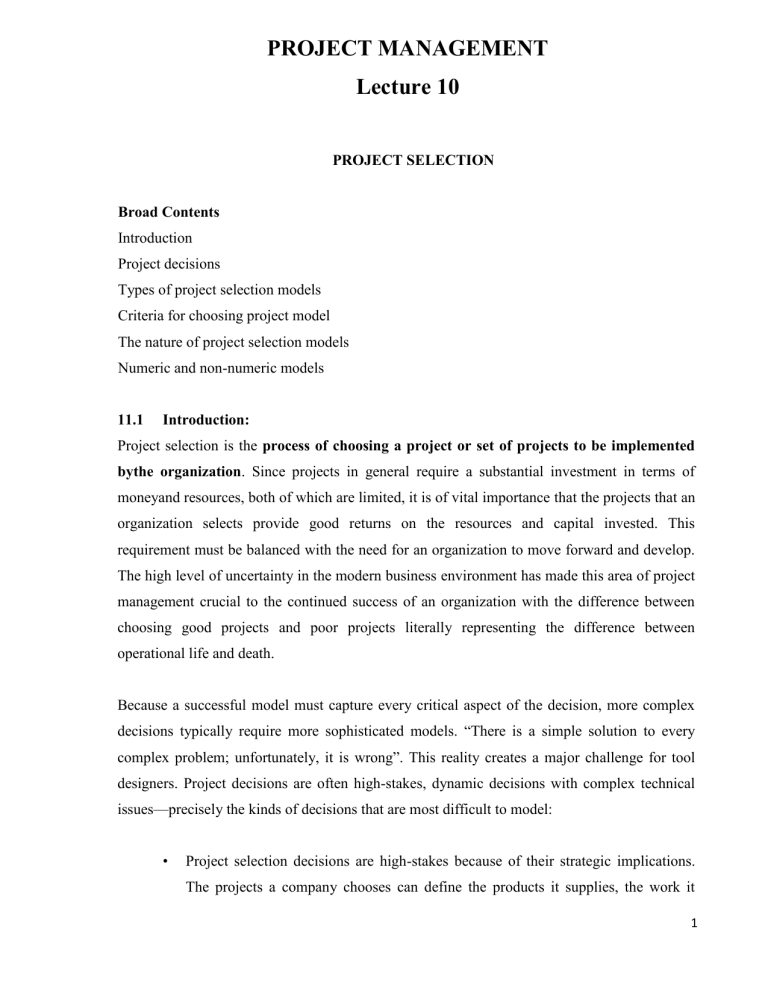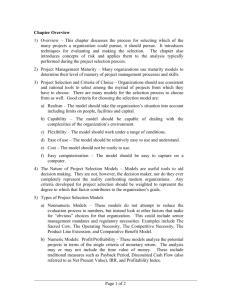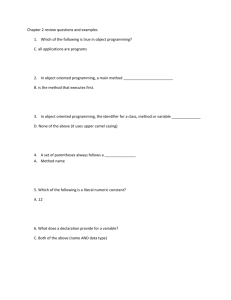PROJECT MANAGEMENT Lecture 10

PROJECT MANAGEMENT
Lecture 10
Broad Contents
Introduction
Project decisions
Types of project selection models
Criteria for choosing project model
PROJECT SELECTION
The nature of project selection models
Numeric and non-numeric models
11.1
Introduction:
Project selection is the process of choosing a project or set of projects to be implemented bythe organization . Since projects in general require a substantial investment in terms of moneyand resources, both of which are limited, it is of vital importance that the projects that an organization selects provide good returns on the resources and capital invested. This requirement must be balanced with the need for an organization to move forward and develop.
The high level of uncertainty in the modern business environment has made this area of project management crucial to the continued success of an organization with the difference between choosing good projects and poor projects literally representing the difference between operational life and death.
Because a successful model must capture every critical aspect of the decision, more complex decisions typically require more sophisticated models. “There is a simple solution to every complex problem; unfortunately, it is wrong”. This reality creates a major challenge for tool designers. Project decisions are often high-stakes, dynamic decisions with complex technical issues—precisely the kinds of decisions that are most difficult to model:
• Project selection decisions are high-stakes because of their strategic implications.
The projects a company chooses can define the products it supplies, the work it
1
does, and the direction it takes in the marketplace. Thus, project decisions can impact every business stakeholder, including customers, employees, partners, regulators, and shareholders. A sophisticated model may be needed to capture strategic implications.
•
Project decisions are dynamic because a project may be conducted over several budgeting cycles, with repeated opportunities to slow, accelerate, re-scale, or terminate the project. Also, a successful project may produce new assets or products that create time-varying financial returns and other impacts over many years. A more sophisticated model is needed to address dynamic impacts.
•
Project decisions typically produce many different types of impacts on the organization. For example, a project might increase revenue or reduce future costs.
It might impact how customers or investors perceive the organization. It might provide new capability or learning, important to future success. Making good choices requires not just estimating the financial return on investment; it requires understanding all of the ways that projects add value. A more sophisticated model is needed to account for all of the different types of potential impacts that project selection decisions can create.
11.2
Project Decisions:
Project decisions often entail risk and uncertainty. The significance of a project risk depends on the nature of that risk and on the other risks that the organization is taking. A more sophisticated model is needed to correctly deal with risk and uncertainty.
Project selection is the process of evaluating individual projects or groups of projects, and then choosing to implement some set of them so that the objectives of the parent organization will be achieved. This same systematic process can be applied to any area of the organization’s business in which choices must be made between competing alternatives. For example:
•
A manufacturing firm can use evaluation/selection techniques to choose which machine to adopt in a part-fabrication process.
•
A television station can select which of several syndicated comedy shows to rerun
2
in its 7:30 p.m. weekday time-slot
• A construction firm can select the best subset of a large group of potential projects on which to bid
•
A hospital can find the best mix of psychiatric, orthopedic, obstetric, and other beds for a new wing.
Each project will have different costs, benefits, and risks. Rarely are these known with certainty. In the face of such differences, the selection of one project out of a set is a difficult task. Choosing a number of different projects, a portfolio , is even more complex. In the following sections, we discuss several techniques that can be used to help senior managers select projects. Project selection is only one of many decisions associated with project management.
To deal with all of these problems, we use decision aiding models. We need such models because they abstract the relevant issues about a problem from the plethora of detail in which the problem is embedded. Reality is far too complex to deal with in its entirety. An “idealist” is needed to strip away almost all the reality from a problem, leaving only the aspects of the
“real” situation with which he or she wishes to deal. This process of carving away the unwanted reality from the bones of a problem is called modeling the problem. The idealized version of the problem that results is called a model.
The model represents the problem’s structure, its form. Every problem has a form, though often we may not understand a problem well enough to describe its structure. We will use many models in this book—graphs, analogies, diagrams, as well as flow graph and network models to help solve scheduling problems, and symbolic (mathematical) models for a number of purposes.
Models may be quite simple to understand, or they may be extremely complex. In general, introducing more reality into a model tends to make the model more difficult to manipulate. If the input data for a model are not known precisely, we often use probabilistic information; that is, the model is said to be stochastic rather than deterministic.
3
Again, in general, stochastic models are more difficult to manipulate. We live in the midst of what has been called the “knowledge explosion.” We frequently hear comments such as “90 percent of all we know about physics has been discovered since Albert Einstein published his original work on special relativity”; and “80 percent of what we know about the human body has been discovered in the past 50 years.” In addition, evidence is cited to show that knowledge is growing exponentially.
Such statements emphasize the importance of the management of change. To survive, firms should develop strategies for assessing and reassessing the use of their resources. Every allocation of resources is an investment in the future. Because of the complex nature of most strategies, many of these investments are in projects.
To cite one of many possible examples, special visual effects accomplished through computer animation are common in the movies and television shows we watch daily. A few years ago they were unknown. When the capability was in its idea stage, computer companies as well as the firms producing movies and television shows faced the decision whether or not to invest in the development of these techniques. Obviously valuable as the idea seems today, the choice was not quite so clear a decade ago when an entertainment company compared investment in computer animation to alternative investments in a new star, a new rock group, or a new theme park.
The proper choice of investment projects is crucial to the long-run survival of every firm. Daily we witness the results of both good and bad investment choices. In our daily newspapers we read of Cisco System’s decision to purchase firms that have developed valuable communication network software rather than to develop its own software. We read of Procter and Gamble’s decision to invest heavily in marketing its products on the Internet; British
Airways’ decision to purchase passenger planes from Airbus instead of from its traditional supplier, Boeing; or problems faced by school systems when they update student computer labs—should they invest in Windows-based systems or stick with their traditional choice,
Apple®. But can such important choices be made rationally? Once made, do they ever change, and if so, how? These questions reflect the need for effective selection models.
4
Within the limits of their capabilities, such models can be used to increase profits, select investments for limited capital resources, or improve the competitive position of the organization. They can be used for ongoing evaluation as well as initial selection, and thus, are a key to the allocation and reallocation of the organization’s scarce resources.
11.2.1
Modeling:
A model is an object or concept, which attempts to capture certain aspects of the real world.
The purpose of models can vary widely, they can be used to test ideas, to help teach or explain new concepts to people or simply as decorations. Since the uses that models can be put are so many it is difficult to find a definition that is both clear and conveys all the meanings of the word. In the context of project selection the following definition is useful:
“A model is an explicit statement of our image of reality. It is a representation of the relevant aspects of the decision with which we are concerned. It represents the decision area by structuring and formalizing the information we possess about the decision and, in doing so, presents reality in a simplified organized form. A model, therefore, provides us with an abstraction of a more complex reality”. (Cooke and Slack, 1991)
When project selection models are seen from this perspective it is clear that the need for them arises from the fact that it is impossible to consider the environment, within which a project will be implemented, in its entirety. The challenge for a good project selection model is therefore clear. It must balance the need to keep enough information from the real world to make a good choice with the need to simplify the situation sufficiently to make it possible to come to a conclusion in a reasonable length of time.
11.3
Criteria for Choosing Project Model:
When a firm chooses a project selection model, the following criteria, based on Souder (1973), are most important:
1.
Realism:
The model should reflect the reality of the manager’s decision situation, including the multiple objectives of both the firm and its managers. Without a common measurement system, direct comparison of different projects is impossible.
5
For example, Project A may strengthen a firm’s market share by extending its facilities, and
Project B might improve its competitive position by strengthening its technical staff. Other things being equal, which is better? The model should take into account therealities of the firm’s limitations on facilities, capital, personnel, and so forth. The model should also include factors that reflect project risks, including the technical risks of performance, cost, and time as well as the market risks of customer rejection and other implementation risks.
2.
Capability:
The model should be sophisticated enough to deal with multiple time periods, simulate various situations both internal and external to the project (for example, strikes, interest rate changes), and optimize the decision. An optimizing model will make the comparisons that management deems important, consider major risks and constraints on the projects, and then select the best overall project or set of projects.
3.
Flexibility:
The model should give valid results within the range of conditions that the firm might experience. It should have the ability to be easily modified, or to be self-adjusting in response to changes in the firm’s environment; for example, tax laws change, new technological advancements alter risk levels, and, above all, the organization’s goals change.
4.
Ease of Use:
The model should be reasonably convenient, not take a long time to execute, and be easy to use and understand. It should not require special interpretation, data that are difficult to acquire, excessive personnel, or unavailable equipment. The model’s variables should also relate oneto-one with those real-world parameters, the managers believe significant to the project.
Finally, it should be easy to simulate the expected outcomes associated with investments in different project portfolios.
5.
Cost:
6
Data gathering and modeling costs should be low relative to the cost of the project and must surely be less than the potential benefits of the project. All costs should be considered, including the costs of data management and of running the model. Here, we would also add a sixth criterion:
6.
Easy Computerization:
It should be easy and convenient to gather and store the information in a computer database, and to manipulate data in the model through use of a widely available, standard computer package such as Excel, Lotus 1-2-3, Quattro Pro, and like programs. The same ease and convenience should apply to transferring the information to any standard decision support system.
In what follows, we first examine fundamental types of project selection models and the characteristics that make any model more or less acceptable. Next we consider the limitations, strengths, and weaknesses of project selection models, including some suggestions of factors to consider when making a decision about which, if any, of the project selection models to use.
We then discuss the problem of selecting projects when high levels of uncertainty about outcomes, costs, schedules, or technology are present, as well as some ways of managing the risks associated with the uncertainties.
Finally, we comment on some special aspects of the information base required for project selection. Then we turn our attention to the selection of a set of projects to help the organization achieve its goals and illustrate this with a technique called the ProjectPortfolio
Process. We finish the chapter with a discussion of project proposals.
11.4
The Nature of Project Selection Models:
There are two basic types of project selection models, numeric and nonnumeric . Both are widely used. Many organizations use both at the same time, or they use models that are combinations of the two. Nonnumeric models, as the name implies, do not use numbers as inputs. Numeric models do, but the criteria being measured may be either objective or subjective. It is important to remember that the qualities of a project may be represented by numbers, and that subjective measures are not necessarily less useful or reliable than objective measures.
7
Before examining specific kinds of models within the two basic types, let us consider just what we wish the model to do for us, never forgetting two critically important, but often overlooked facts.
•
Models do not make decisions—people do. The manager, not the model, bears responsibility for the decision. The manager may “delegate” the task of making the decision to a model, but the responsibility cannot be abdicated.
•
All models, however sophisticated, are only partial representations of the reality they are meant to reflect. Reality is far too complex for us to capture more than a small fraction of it in any model. Therefore, no model can yield an optimal decision except within its own, possibly inadequate, framework.
We seek a model to assist us in making project selection decisions. This model should possess the characteristics discussed previously and, above all, it should evaluate potential projects by the degree to which they will meet the firm’s objectives. To construct a selection/evaluation model, therefore, it is necessary to develop a list of the firm’s objectives.
A list of objectives should be generated by the organization’s top management. It is a direct expression of organizational philosophy and policy. The list should go beyond the typical clichés about “survival” and “maximizing profits,” which are certainly real goals but are just as certainly not the only goals of the firm. Other objectives might include maintenance of share of specific markets, development of an improved image with specific clients or competitors, expansion into a new line of business, decrease in sensitivity to business cycles, maintenance of employment for specific categories of workers, and maintenance of system loading at or above some percent of capacity, just to mention a few.
A model of some sort is implied by any conscious decision. The choice between two or more alternative courses of action requires reference to some objective(s), and the choice is thus, made in accord with some, possibly subjective, “model.” Since the development of computers and the establishment of operations research as an academic subject in the mid -1950s, the use of formal, numeric models to assist in decision making has expanded. Many of these models use financial metrics such as profits and/or cash flow to measure the “correctness” of a managerial decision. Project selection decisions are no exception, being based primarily on the
8
degree to which the financial goals of the organization are met. As we will see later, this stress on financial goals, largely to the exclusion of other criteria, raises some serious problems for the firm, irrespective of whether the firm is for profit or not-for-profit.
When the list of objectives has been developed, an additional refinement is recommended. The elements in the list should be weighted. Each item is added to the list because it represents a contribution to the success of the organization, but each item does not make an equal contribution. The weights reflect different degrees of contribution each element makes in accomplishing a set of goals.
Once the list of goals has been developed, one more task remains. The probable contribution of each project to each of the goals should be estimated. A project is selected or rejected because it is predicted to have certain outcomes if implemented.
These outcomes are expected to contribute to goal achievement. If the estimated level of goal achievement is sufficiently large, the project is selected. If not, it is rejected.
The relationship between the project’s expected results and the organization’s goals must be understood. In general, the kinds of information required to evaluate a project can be listed under production, marketing, financial, personnel, administrative, and other such categories.
The following table 11.1 is a list of factors that contribute, positively or negatively, to these categories.
In order to give focus to this list, we assume that the projects in question involve the possible substitution of a new production process for an existing one. The list is meant to be illustrative.
It certainly is not exhaustive.
9
Table 11.1: Factors Contributing to Various Organizational Categories
Some factors in this list have a one-time impact and some recur. Some are difficult to estimate and may be subject to considerable error. For these, it is helpful to identify a range ofuncertainty. In addition, the factors may occur at different times.
And some factors may have thresholds, critical values above or below which we might wish to reject the project. We will deal in more detail with these issues later in this chapter.
Clearly, no single project decision needs to include all these factors. Moreover, not only is the
10
list incomplete, it also contains redundant items. Perhaps more important, the factors are not at the same level of generality: profitability and impact on organizational image both affect the overall organization, but impact on working conditions is more oriented to the production system. Nor are all elements of equal importance.
Change in production cost is usually considered more important than impact on current suppliers. Shortly, we will consider the problem of generating an acceptable list of factors andmeasuring their relative importance. At that time we will discuss the creation of a Decision
Support System (DSS) for project evaluation and selection.
The same subject will arise once more in the next lecture(s) when we consider project auditing, evaluation, and termination.
Although the process of evaluating a potential project is time-consuming and difficult, its importance cannot be overstated. A major consulting firm has argued (Booz, Allen, and
Hamilton, 1966) that the primary cause for the failure of Research and Development (R and D) projects is insufficient care in evaluating the proposal before the expenditure of funds. What is true for such projects also appears to be true for other kinds of projects, and it is clear that product development projects are more successful if they incorporate user needs and satisfaction in the design process (Matzler and Hinterhuber, 1998). Careful analysis of a potential project is a sine qua non for profitability in the construction business. There are many horror stories (Meredith, 1981) about firms that undertook projects for the installation of a computer information system without sufficient analysis of the time, cost, and disruption involved.
Later, we will consider the problem of conducting an evaluation under conditions of uncertainty about the outcomes associated with a project. Before dealing with this problem, however, it helps to examine several different evaluation/selection models and consider their strengths and weaknesses. Recall that the problem of choosing the project selection model itself will also be discussed later.
30.6
Types of Project Selection Models:
11
Of the two basic types of selection models (numeric and nonnumeric), nonnumeric models are older and simpler and have only a few subtypes to consider. We examine them first.
•
Non-Numeric Models:
These include the following:
1.
The Sacred Cow:
In this case the project is suggested by a senior and powerful official in the organization. Often the project is initiated with a simple comment such as, “If you have a chance, why don’t you look into . . .,” and there follows an undeveloped idea for a new product, for the development of a new market, for the design and adoption of a global database and information system, or for some other project requiring an investment of the firm’s resources. The immediate result of this bland statement is the creation of a “project” to investigate whatever the boss has suggested.
The project is “sacred” in the sense that it will be maintained until successfully concluded, or until the boss, personally, recognizes the idea as a failure and terminates it.
2.
The Operating Necessity:
If a flood is threatening the plant, a project to build a protective dike does not require much formal evaluation, which is an example of this scenario. XYZ Steel Corporation has used this criterion (and the following criterion also) in evaluating potential projects. If the project is required in order to keep thesystem operating, the primary question becomes: Is the system worth saving at the estimated cost of the project? If the answer is yes, project costs will be examined to make sure they are kept as low as is consistent with project success, but the project will be funded.
12
3.
The Competitive Necessity:
Using this criterion, XYZ Steel undertook a major plant rebuilding project in the late 1960s in its steel bar manufacturing facilities near Chicago. It had become apparent to XYZ’s management that the company’s bar mill needed modernization if the firm was to maintain its competitive position in the Chicago market area. Although the planning process for the project was quite sophisticated, the decision to undertake the project was based on a desire to maintain the company’s competitive position in that market.
In a similar manner, many business schools are restructuring their undergraduate and Masters in Business Administration (MBA) programs to stay competitive with the more forward looking schools. In large part, this action is driven by declining numbers of tuition paying students and the need to develop stronger programs to attract them.
Investment in an operating necessity project takes precedence over a competitive necessity project, but both types of projects may bypass the morecareful numeric analysis used for projects deemed to be less urgent or less important to the survival of the firm.
4.
The Product Line Extension:
In this case, a project to develop and distribute new products would be judged on the degree to which it fits the firm’s existing product line, fills a gap, strengthens a weak link, or extends the line in a new, desirable direction.
Sometimes careful calculations of profitability are not required. Decision makers can act on their beliefs about what will be the likely impact on the total system performance if the new product is added to the line.
5.
Comparative Benefit Model:
For this situation, assume that an organization has many projects to consider, perhaps several dozen. Senior management would like to select a subset of the projects that would most benefit the firm, but the projects do not seem to be easily comparable. For example, some projects concern potential new products, some concern changes in production methods, others concern computerization of certain records, and still others cover a variety of subjects not easily categorized (e.g., a proposal to create a daycare center for employees with small children).
13
The organization has no formal method of selecting projects, but members of the selection committee think that some projects will benefit the firm more than others, even if they have no precise way to define or measure “benefit.”
The concept of comparative benefits, if not a formal model, is widely adopted for selection decisions on all sorts of projects. Most United Way organizations use the concept to make decisions about which of several social programs to fund. Senior management of the funding organization then examines all projects with positive recommendations and attempts to construct a portfolio that best fits the organization’s aims and its budget.
14









